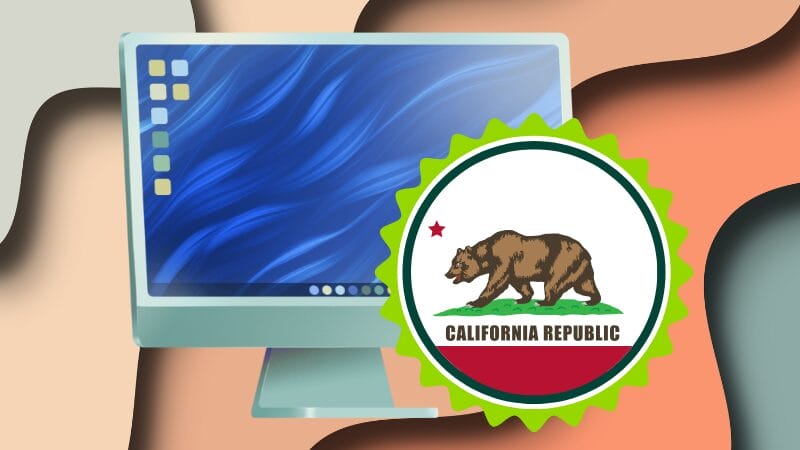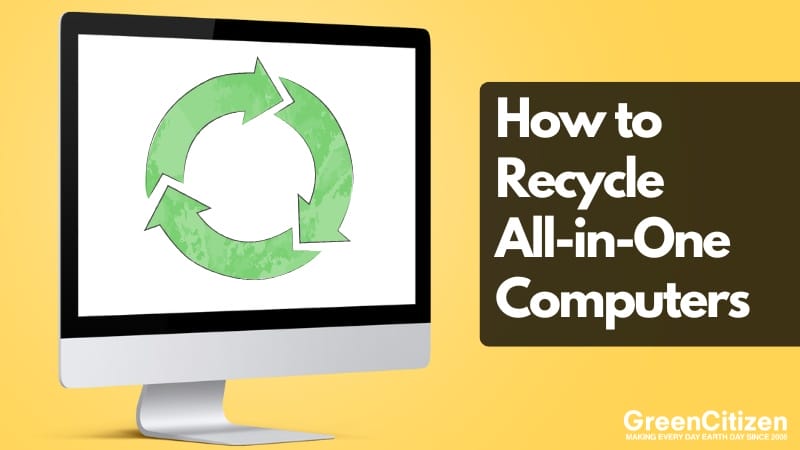Recycling all-in-one computers — like your old Apple iMac or HP Pavilion AIO — isn’t as simple as hauling them to the curb. These compact machines combine a full desktop and monitor in a single shell, which classifies them as e-waste in California and makes proper recycling a legal requirement.
Because the monitor and hardware are integrated into one unit, recycling AIO computers requires handling both display and internal components — including toxic materials and sensitive data.
Tossing one in the trash isn’t just illegal — it can lead to data breaches, environmental harm, or costly non-compliance for businesses.
Whether you’re recycling a single all-in-one PC at home or retiring multiple units from an office, this guide shows you how to recycle all-in-one computers safely, legally, and sustainably — with options for Bay Area drop-offs, business pickups, and nationwide mail-in recycling.
Key Takeaway: How to Recycle All-in-One Computers
All-in-one computers are recyclable, but only through certified e-waste programs — not landfills or junk haulers. From data protection to environmental safety, proper recycling ensures legal compliance and resource recovery. Whether you’re in the Bay Area or beyond, use a certified recycling service for your AIO device.
What Is an All-in-One Computer (AIO) and How Is It Different from a Desktop?
An all-in-one computer (AIO) is a type of desktop PC that combines the monitor and internal hardware — like the CPU, motherboard, hard drive, and speakers — into a single space-saving unit.
Instead of a separate tower and screen like traditional desktops, an AIO PC integrates everything behind the display for a compact, clutter-free setup. This design cuts down on cable clutter and saves desk space, making AIO PCs a popular choice in minimalist home offices, classrooms, and business environments.
Common Examples of All-in-One Computers
- Apple iMac
- HP Pavilion All-in-One
- HP EliteOne
- Dell Inspiron AIO
- Dell OptiPlex AIO
- Lenovo IdeaCentre
- Lenovo ThinkCentre M Series AIO
- Acer Aspire C Series
- Acer Aspire Z24
- ASUS Zen AiO
- Microsoft Surface Studio
- MSI Pro 24X
- Samsung All-in-One 7
While these systems offer the same full functionality as standard desktops, their compact, enclosed structure makes them harder to take apart — and harder to recycle.
Proper e-waste handling is crucial to safely recover materials and protect any sensitive data stored inside.
Can You Recycle an All-in-One Computer? (And Why It’s Required in California)
Yes, all-in-one computers (AIOs) are recyclable, but only through certified electronics recycling programs. They cannot be placed in the trash or recycled curbside because they contain hazardous materials like lead solder, mercury in displays, lithium-ion batteries — and internal storage that may hold sensitive data.
All-in-one computers are classified as electronic waste under most U.S. state laws, including California’s CEW program. They must be recycled through certified e-waste facilities to prevent environmental harm and protect sensitive data.

California Regulations for All-in-One Computer Disposal
In California, all-in-one computers are regulated under both Universal Waste and Covered Electronic Waste (CEW) programs. Throwing them in the trash is illegal. Businesses must use R2 or e-Stewards certified recyclers and ensure hard drives are wiped or destroyed to comply with environmental and data privacy standards.
Improper disposal can result in fines, legal penalties, and audit failures — especially for organizations recycling multiple units at once.
Does SB 20 Apply to All-in-One Computers?
Yes, if the AIO has a display larger than 4 inches (measured diagonally) and is technologically based on CRT, LCD, LED, or plasma — it qualifies as a Covered Electronic Device (CED) under SB 20 program.
The law was later amended by SB 50 (2004) to expand the list of covered devices, and AIO computers with integrated displays fall under that expanded scope.
So, Apple iMacs, HP Pavilion AIOs, Dell Inspiron AIOs, etc. — all qualify under CEW if they have an integrated screen and are sold to California consumers.
How to Prepare an All-in-One Computer for Recycling
Before recycling your all-in-one computer, take a few important steps to protect your data and ensure safe, compliant disposal.
Here’s how to prepare your AIO for recycling the right way:
1. Back Up and Erase Your Data
All-in-one computers may contain sensitive files or personal information. Back up what you need, then perform a secure data wipe.
- On macOS: Use Disk Utility or reinstall macOS to erase the drive.
- On Windows: Use Reset This PC with “Remove Everything” selected.
2. Unplug and Remove External Devices
Disconnect all accessories, including:
- Keyboard, mouse, USB drives, memory cards
- Power cable and any display adapters
3. Check for Damage or Battery Issues
If your AIO has a built-in lithium-ion battery, check for swelling or heat damage. Leaking batteries pose a fire risk and must be handled with care by certified e-waste professionals.
4. Label and Pack for Transport
- Use anti-static wrap, original packaging, or a padded box.
- Clearly label the box “Electronics for Recycling.”
- If you’re using a business pickup service, group multiple AIOs together by model type for faster processing.
💡 Pro Tip: Always check for battery swelling before powering on or packing your all-in-one computer. Swollen lithium-ion batteries can ignite during transport — and many recyclers charge extra for unsafe units.
Where to Recycle All-in-One Computers Near You (4 Best AIO Recycling Options)
You can recycle your all-in-one computer through four safe and legal options: certified e-waste recyclers, manufacturer take-back programs, major retailers, and local government electronics recycling events.
These programs ensure your AIO is handled responsibly, not dumped or landfilled.
Whether you’re recycling one old iMac at home or clearing out multiple AIOs from your office, the options below work for both individuals and businesses.
1. Certified Electronics Recycling Centers
Best for: Legal, safe disposal and business compliance
Certified e-waste facilities ensure your AIO PC is handled responsibly. Look for recyclers with R2 or e-Stewards certification and a documented chain of custody.
Best Bay Area Option of AIO Recycling:
GreenCitizen’s Burlingame EcoCenter offers:
- Walk-in AIO drop-off for residents
- Business pickups across the San Francisco Bay Area
- GTAMS tracking by serial/asset tag
- Full documentation for ESG and audit compliance
💡 Tip: Ideal for offices recycling multiple iMacs or AIO desktops.
2. Manufacturer Take-Back Programs
Best for: Brand-specific returns or trade-ins
Most major brands offer free recycling or trade-in programs:
- Apple: Recycle or trade in iMacs
- HP & Dell: Mail-in labels, store credit, or product discounts
These programs are easy for consumers, but these OEM manufacturers usually do not provide chain-of-custody tracking, data destruction certificates, or regulatory compliance documentation — making them unsuitable for businesses with ESG or IT audit requirements.
Check each site for eligible models, trade-in value, and shipping instructions.
💡 Tip: Back up and wipe your data before sending — manufacturer programs assume no liability for data left on the device.
3. Retail Drop-Off Programs
Best for: Quick consumer recycling of working or broken AIOs
Retailers like Best Buy and Staples accept all-in-one PCs for recycling.
Things you should know before going for retail drop-off programs:
- Daily item limits apply (often 3 per household)
- Business electronics usually not accepted
- Availability varies by store — call ahead
💡 Tip: Some stores offer free drop-off, others charge per item.
4. Local E-Waste Events or HHW Sites
Best for: Residents looking for free, local disposal
City and county governments often organize e-waste recycling events or operate permanent household hazardous waste (HHW) drop-off sites for residents.
These are convenient for recycling one or two old AIOs, but they are not designed for businesses. Most programs prohibit bulk drop-offs, require proof of residency, and do not provide documentation for audit or compliance tracking.
💡 Tip: Search “[your city] + e-waste event” or “HHW drop-off near me” to find the next scheduled date near you.
⚠️ Never throw an all-in-one PC in the trash or use curbside bins or junk haulers — it’s illegal in many states and may expose hazardous materials.
How GreenCitizen Recycles All-in-One Computers (Best for Bay Area Businesses)
While many recycling options exist, few offer full traceability, data protection, and environmental guarantees. That’s where GreenCitizen stands apart.
Whether you’re recycling a single iMac or decommissioning 50 HP AIOs, we handle every device with precision and accountability — so you don’t have to worry about compliance gaps, audit failures, or environmental harm.
Full Accountability with GTAMS
Every all-in-one computer is logged by serial or asset tag into our proprietary GreenCitizen Total Accountability Management System (GTAMS).
This gives you:
- A complete audit trail
- Certificates of Recycling & Data Destruction
- Compliance with NIST 800-88, DoD, and ESG standards
No other Bay Area recycler offers this level of transparency for walk-ins, business pickups, or national mail-in.
No Landfill. No Overseas Dumping.
Unlike junk haulers or uncertified recyclers, we never export electronics illegally or send materials to landfills.
All materials are processed through R2-certified, U.S.-based recyclers — ensuring responsible demanufacturing from screen to circuit board.
Designed for IT Departments, Office Managers, and Compliance Leads
We understand the real risks behind e-waste:
- Fines up to $70,000/day under California DTSC rules
- Multi-million-dollar data breach liabilities
- Missed ESG reporting targets
That’s why our business pickup service includes:
- Secure logistics across the entire Bay Area
- Support for bulk recycling of computers, monitors, and peripherals
- Fast onboarding and scheduling with minimal office disruption
Built for Everyone, Available Everywhere
Outside the Bay Area? Our nationwide mail-in recycling gives remote teams and individuals the same GTAMS tracking, ESG-ready documentation, and certified peace of mind.
FAQ: All-in-One Computer Recycling
No. All-in-one computers contain hazardous materials like lead, mercury, and lithium-ion batteries. In most states — including California — it’s illegal to dispose of them in the trash or at the curb. They must be recycled through certified e-waste programs.
Yes. Apple accepts old iMacs through its Apple Trade In and recycling program. You can receive credit toward a new purchase or request a free mail-in kit for safe disposal if your device has no value.
Use your computer’s built-in reset tools to securely wipe the hard drive: On macOS, use Disk Utility or reinstall macOS. On Windows, go to “Reset this PC” and choose “Remove Everything.”
Yes. All-in-one computers are classified as electronic waste (e-waste) under state and federal regulations. Because they contain circuit boards, batteries, and display components, they require special handling by certified e-waste recyclers.
Why Certified Recycling Is the Only Safe Way to Dispose of Your All-in-One Computer
All-in-one computers may look minimal on the outside, but inside they house lithium-ion batteries, mercury-based displays, lead solder, and hard drives that can expose toxic waste or sensitive data if mishandled. That’s why certified recycling isn’t optional — it’s essential.
Whether you’re disposing of a single iMac at home or retiring dozens of HP AIOs from your office, your recycling method must be:
- Legal (landfill disposal is banned in California)
- Secure (data-bearing drives must be wiped or destroyed)
- Sustainable (recover valuable metals and avoid environmental harm)
GreenCitizen provides full-service, GTAMS-tracked all-in-one computer recycling for residents and businesses. Each device is logged by serial or asset tag, and businesses receive Certificates of Recycling, Data Destruction Reports, and documentation that meets ESG and compliance standards.
- No illegal export.
- No landfill.
- No guessing where your device ends up.
